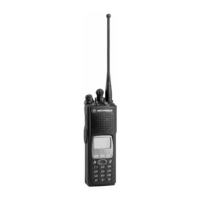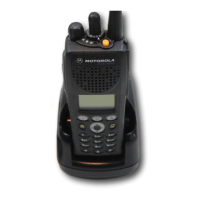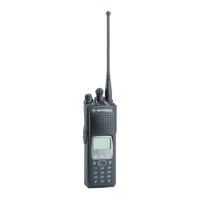Basic Theory of Operation
9
and adjusts PA control voltages. The transmitter RF signal then passes
through a PIN diode antenna switch and a low-pass harmonic filter,
which connects to the antenna connector.
VOCON Board Basic
Theory of
Operation
The vocoder and controller (VOCON) board comprises the dual-core
processor, which contains the radio’s microcontrol unit and digital
signal processor (DSP) in a single integrated circuit (IC) package, its
memory ICs, an audio and power supply IC, a digital support IC, and
the audio power amplifier. Connected to the VOCON board are the
liquid-crystal display (LCD) board, XCVR board, keypad flex, controls/
universal flex, and (optional) encryption module.
The microcontrol unit portion of the dual-core processor controls
receive/transmit frequencies, power levels, display, and other radio
functions, using either direct logic control or serial communications
paths to the devices. The microcontrol unit executes a stored program
located in the FLASH memory device. Data is transferred to and from
memory by the microcontrol unit data bus. The memory location
from which data is read, or to which data is written, is selected by the
address lines. The microcontrol unit of the dual-core processor
requires a 16.8MHz clock on its CKIH pin and a 32kHz clock on its
CKIL pin.
The DSP portion of the dual-core processor performs signaling and
voice encoding and decoding, as well as audio filtering and volume
control. The DSP performs Private-Line®/Digital Private Line™ (PL/
DPL) encode and alert-tone generation. The DSP transmits pre-
emphasis on analog signals, and applies a low-pass (splatter) filter to
all transmitted signals. The DSP controls squelch, deviation, and
executes receiver and transmitter filtering. The DSP executes a stored
program located in the FLASH memory device.
The DSP of the dual-core processor requires a 16.8MHz clock on the
CKIH pin. Additionally, it requires the 520kHz clock and 8kHz
interrupt signal from the digital support IC, as well as clocks from the
Abacus III digital back-end IC on the XCVR board.
The digital support IC is supplied with a 16.8MHz clock from the
XCVR board. Using this clock, the digital support IC generates a
13MHz clock for the analog and power supply IC, and a 520kHz clock
and an 8kHz interrupt signal for both the DSP and the analog and
power supply IC. Additionally, the digital support IC uses a crystal to
generate the 32kHz clock used by the dual-core processor and audio
and power supply IC. It monitors the position of the on/off switch and
controls the shutdown of the regulators on the audio and power
supply IC. Finally, the digital support IC interfaces to the radio’s 13-pin
universal (accessory) connector. This IC is programmed by the dual-
core processor.
The analog and power supply IC has many functions. This IC supplies
most of the voltages used on the VOCON board, while an external
linear regulator supplies 5 volts. It also has microphone audio
amplifiers, switching between internal and accessory microphones,
and the audio CODEC. The audio CODEC performs analog-to-digital
and digital-to-analog conversions on audio signals. It also has an

